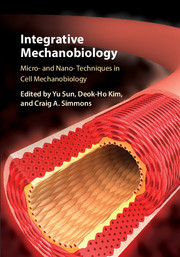Part II - Recent progress in cell mechanobiology
Published online by Cambridge University Press: 05 November 2015
Summary
Tumor angiogenesis is a key regulator of tumor growth and metastasis. Assays allowing the analysis of tumor angiogenesis are an essential tool to elucidate the role played by the tumor microenvironment in regulating tumor angiogenesis. The assays should also be capable of systematically investigating the effects of physiologically relevant, mechanical and chemical stimuli and their synergistic interactions. The high optical resolution of microfluidic assays facilitates three-dimensional studies of cellular morphogenesis. Their versatility can be applied to study the multi-parameter control of angiogenic factors.
- Type
- Chapter
- Information
- Integrative MechanobiologyMicro- and Nano- Techniques in Cell Mechanobiology, pp. 203 - 367Publisher: Cambridge University PressPrint publication year: 2015



